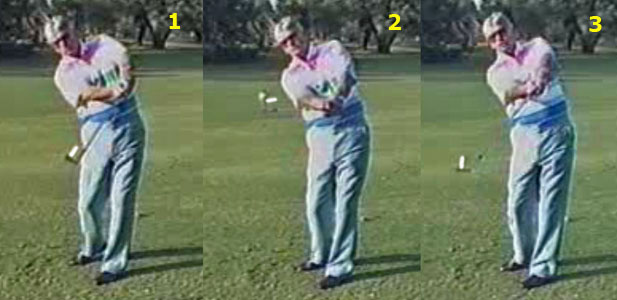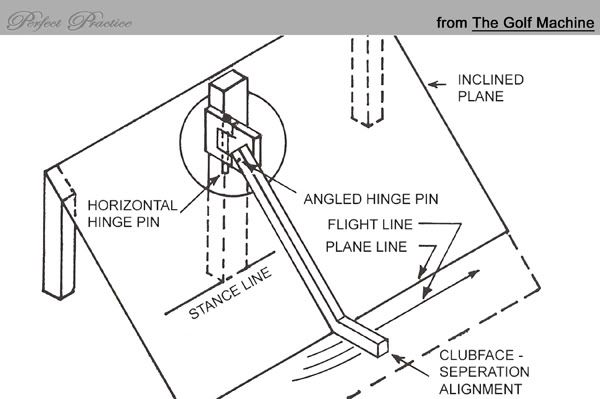
7-10 (Hinge Actions)
There are 3 hinge actions...Horizontal, Angled and Vertical Hinge Actions. These can be used with all motions and all clubs, except for the Horizontal Hinge Action with the Putter. In the putter, the golfer should either use either Angled Hinge Action (Arced Putting Stroke) or the Vertical Hinge Action (Straight Back - Straight Thru Stroke).
'Hinge Actions' describe and control the manipulation of the Hands through the Impact Interval. The Hand manipulation in turn controls the Clubface MOTIONS.' - Homer Kelley pg. 102All of the Hinge Actions in the normal swing are still executed on an Inclined plane. You may rotate the plane line left (or right), but they still require a straight plane and executing on an inclined plane.
Homer Kelley states that it's good to practice all of the hinge motions with just the left arm only. I agree. Always good to understand them all and be able to execute them all so you can get a good feel and sense for each action and then be able to use that knowledge and FEEL in order to operate your preferred hinge action time and time again. For instance, I can execute horizontal hinging, but I used Angled Hinging in my normal swing. While I'm not as consistent at executing horizontal hinging, just understanding and sensing that hinge action has helped me with my angled and vertical hinge action. Here again is the pics of Tommy Tomasello displaying the different Hinge Actions from Jeff Mann's Web site.

#1 Pic = Angled Hinge = No Roll FEEL
#2 Pic = Horizontal Hinge = Full Roll FEEL
#3 Pic = Vertical Hinge = Reverse Roll FEEL
Chronic Fades and Pushes can mean insufficient Roll. Chronic Draws and Pulls can mean excessive Roll.It's important to note that the 'machine' has a 'hinge pin' attached to it. Here's a diagram of the 'machine.'

Homer states:
The 'Hinges' are actually mounted at the Left Shoulder but the real control comes with moving or holding the Left Wrist in the positions called for by the respective Hinge arrangements.Here's a couple of Lynn Blake videos talking about the hinge action and the 'hinge pin.'
So the hinge action deals a lot with the the left arm hinging from the left shoulder joint. The problem a lot of golfers have is that they:
1. Use the wrong Hinge Action for their swing
This occurs when a 'hitter' uses a horizontal hinge action. Or even worse, when a hitter or a swinger uses a vertical hinge action on a full swing. I used to have a problem with the latter. My grip was so strong and my clubface was so closed at the top, I started to open the clubface on the downswing as a means to square the clubface at impact, but that would lead to a vertical hinge action.
2. Don't execute any of the hinge actions correctly.
Usually this comes from flipping at impact or the golfer just 'crossing over' the arms and swiveling the hands way too early. Thru the impact interval the golfer should make their hinge action first, then swivel the hands to finish.
3JACK
7 comments:
thanks for your translation it's really starting to all come together
Are you sure you have those putting strokes correct? Please explain.
What puttting strokes?
Vertical Hinge = SBST stroke
Angled Hinge = Arced Stroke
No Horizontal Hinge in putting stroke.
"This occurs when a 'hitter' uses a horizontal hinge action."
Why is this a bad thing? Snap hooks?
Yes, snap hooks. The hitter doesn't use Centrifigul Force (or at least directly uses CF), when you do it will close the face at impact and cause hooks. If I need a hook around some trees, I'll use horizontal hinge just to guarantee the hook action.
Post a Comment